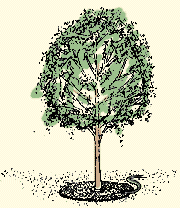| WATERING URBAN TREES | |
This past spring the City of Baltimore planted 1733 new trees. Weekly watering is essential for their survival. The amount of water varies with the size and species of plant and the type of soil that it is growing in. Basically enough water must be made available to replace what the tree or shrub has used. Trees use moisture night and day in every season, even when leaves are not present. Newly planted trees need frequent deep watering during the spring and summer growing season and can also benefit from watering during dry fall and winter periods. Mature established trees generally store enough moisture in their roots even during drought periods. However one or two water applications during the growing season should suffice if rains do not come. The best and most conservative way to accomplish this is to use a lawn sprinkler. Place a drinking glass under the tree. Watering is complete when you can measure 1” to 2” of water in the glass. Watering is critical for the success of new tree plantings. A new street
tree planted in Baltimore has a diameter of two to three inches and stands
about 13’ tall it has only about 20% of its original root mass and will
require frequent weekly watering to thoroughly soak the root ball until
a new root system is developed. New trees need weekly watering equal to
a 1 or 2 inch rainfall or 5 gallons per square yard. One or two slow soakings
with approximately 10 to 20 gallons of water should be adequate. This can
be accomplished by letting a soaker or garden hose trickle under the crown
of the tree for about an hour. A alternative conservative method would
be to place a clean 5 gallon joint compound bucket with small holes in
its bottom at the base of the tree, filling it several times to administer
the desired
The best time to water is in the evening after sunset or early morning. Between 9 PM and 8 AM in Baltimore. Watering between these times allows less evaporation and more water to move into the soil, making it more available to the roots. Cautionary notes; Frequent shallow watering causes soil compaction, runoff problems and encourages surface rooting. Roots tend to dry out quickly when too close to the surface. Shallow watering is the main cause for unsightly surface roots on lawns and raised foot ways in Baltimore. Folks watering flowers or grass commonly do not water long enough to reach the roots of trees. Tree roots can be found as much as 16 inches deep in the soil. On the other hand slow soaking reduces runoff and causes the production of deeper roots and more drought tolerant established trees and shrubs. Avoid the use of fertilizers. Fertilizers are not generally recommended for new trees and can be extremely harmful during drought periods. Over watering a tree or shrub is a typical problem. Tree roots need to breath. Too frequent watering displaces the oxygen in the soil and can damage or kill a tree. Again a tree needs a weekly soaking equal to a one or two inch rain. Even during droughts, trees should not be watered more than two times weekly. Proper mulching is an additional aid to watering and possibly the most important post planting practice that can be done for the vitality of a new tree. Place a layer of mulch at the base of a tree between 2” to 4” high and one inch away from the trunk. Use less mulch closer to the trunk and more at the edge of the ball or drip line in a diameter of 3 to feet wide creating a bowl that suitably holds about 10 gallons of water. Proper mulching will reduce water evaporation making it available to the new tree as needed. In addition to retaining moisture, mulch improves soil conditions it keeps the root ball cool in summer, warm in winter and slowly supplies much needed nutrients to the soil. Mulch keeps unwanted competing plants from growing and its darned attractive too. Avoid harmful over mulching, do not exceed a 4 inch depth and do not place it directly against the trunk of the tree. In the event of mandatory water restrictions the use of ‘Gray Water’
is an effective way to water trees. Gray water is wastewater from bathtubs,
sinks and washing machines. It is advised to use a layer of mulch when
using gray water and avoid contact of the leaves. Gray water may also have
an adverse effect on acid loving plants like azalea and rhododendron.
|
|
| For information contact
Marion J Bedingfield Certified Arborist/Tree Service Technician City of Baltimore Forestry Division 2600 Madison Avenue Baltimore, MD 21217 marion.bedingfield@baltimorecity.gov
|

